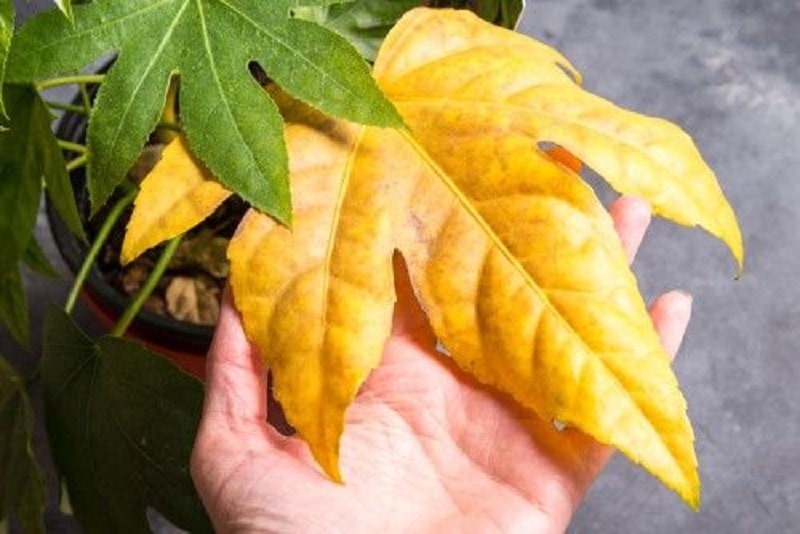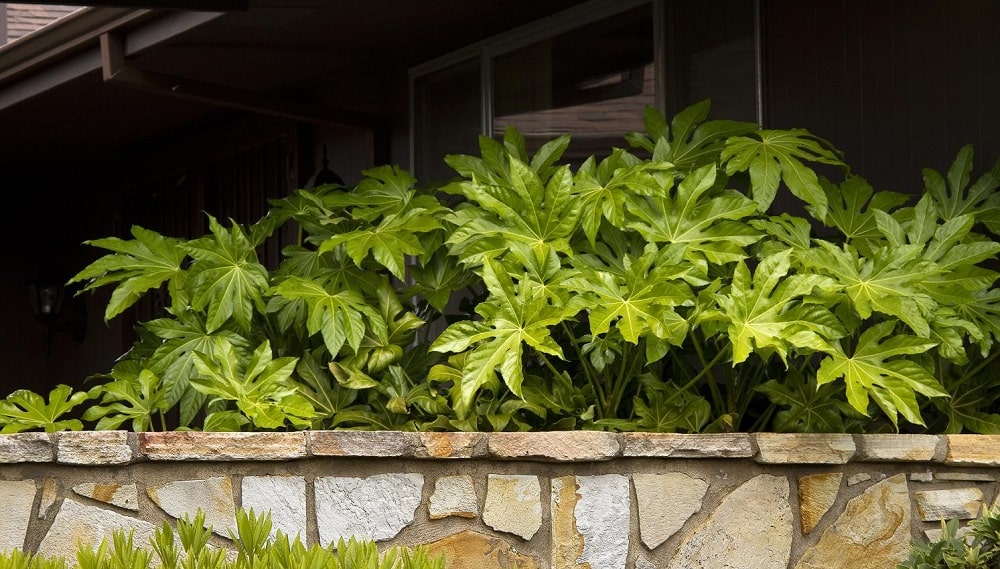When I started growing the aralia plant in my house a couple of years ago, I encountered several challenges along the way. Aralia leaves turning yellow was one of the most frequent problems. I decided to write this article to help you overcome aralia leaves turning yellow with ease.
So, why are my aralia leaves turning yellow? Improper aralia plant care is the reason behind the leaves losing their color and falling off. These ming aralia care issues are improper watering, temperature fluctuation, transplant shock, and inadequate lighting.
It would be best to identify the exact cause of the issue before jumping into measures of saving your dying houseplant. There is no need to freak out as this article will walk you into causes of ming aralia leaves turning yellow and how to fix them.
You May Also Like: 20 Beautiful Alocasia Varieties with Pictures and Names

Causes of Aralia Leaves Turning Yellow with Solutions
Old Foliage
Old leaves are more vulnerable to yellowing. It is a natural process and inevitable. The issue usually happens on the lower leaves of the plant only.
The old leaves will die and fall off in the long run. The process allows the plant to redirect the energy and nutrients to new growths.
Aralia’s old leaves turning yellow are common in winter and autumn. It occurs due to a decrease in sunlight, and the plant has to make few sacrifices for better overall health.
Pest Infestation
Insect infestation is a common phenomenon in all houseplants. But some indoor plants are more susceptible to bugs than others.
Aralia plants are vulnerable to spider mites, mealybugs, and aphids. These insects usually suck vital juices from the plant leaves and stems.
The plant fails to produce adequate chlorophyll due to the piercings by the insects. You’ll notice the leaves of your houseplant turning yellow in the long run.
Aphids are common on outdoor plants, while spider mites and mealybugs attack their indoor counterparts. Learning how to get rid of pests on the aralia plant is crucial.
The rule of thumb is to inspect the houseplant more often and spray it with insecticidal soap. The detergent will help to protect the indoor plant from insect infestations.
Another option is to spray the plant with neem oil (source: New York Botanical Gardens). The alcohol content will help to get rid of the insects from the plant.
Transplant Shock
Most plants do experience shock after an abrupt relocation. It is the reason why houseplant enthusiasts need to exercise ultimate care when uprooting and re-potting.
Aralia plants can withstand the transplant shock. But the aralia leaves turning yellow, and drooping occurs when it is done incorrectly.
Be sure to use a bigger pot than the previous one. Replant it in well-drained soil to prevent sogginess from happening.
Smaller pots make the houseplant suffer from root bound issues. The problem can make your aralia plant have yellow leaves.
The good news is that aralia plants do not suffer much from root-bound. You won’t re-pot the plant more often, and this will allow the plant to continue growing without any disturbance.
Improper Soil pH
Most aralia species thrive in slightly acidic soil. The houseplants love soil with a pH range of 6-6.5 to produce attractive foliage.
Alkaline soil is not ideal for acidic-soil-loving plants. Soil with high pH always lacks vital nutrients for the plants.
Aralia leaves turning yellow is probably due to a lack of nutrients in the soil. If this condition persists, the plant will start developing leggy stems.
Use a pH tester to check your soil pH. Correct the pH if it is too acidic or alkaline to prevent the leaves from turning yellow.
You can use aluminum sulfate and sulfur to reduce the soil pH faster. Another alternative is to water the potting soil with few drops of lemon juice to lower the soil pH.
Overwatering Stress
Aralia plants do not flourish in a soggy and waterlogged environment. The damp condition creates a favorable environment for bacterial and fungal diseases.
Overwatering occurs due to improper soil drainage. The excess water results in a fatal problem to your houseplant in the long run.
The condition inhibits root aeration and absorption of vital nutrients. It is due to root rot disease that suffocates the houseplant.
Aralia leaves turning yellow is the initial sign of root rot. Failure to fix the root problem on time, the entire plant will wilt and die eventually.
You need to understand the water requirement for aralia species. But this will depend on humidity, temperature, season, soil type, and the environment.
Check the soil moisture content by inserting your index finger into the top 2-3 inches of the potting mix. Water the plant if the soil is dry.
Remember to use well-drained soil in a pot with drainage holes at the bottom. These holes help to get rid of excess water to prevent the overwatering issue.
Nutritional Deficiency
Aralia plants love to iron, nitrogen, zinc, and manganese to produce stunning foliages. These nutrients also foster better growth and well-being of the plant.
Aralia species display yellow leaves due to a lack of nutrients. Research shows that insufficient irons in the soil enhance leaf chlorosis.
Besides that, a lack of nitrogen inhibits the plant from producing enough chlorophyll. The pigment is responsible for the green foliage color.
Lack of chlorophyll makes the leaves lose their color and fall off. The best option is to supply your houseplants will fertilizer rich in nitrogen and iron minerals.
Be sure to apply the water-soluble fertilizer around the roots during spring and summer. Aralia dormancy happens in winter. It is the period where most houseplants do not utilize fertilizer.
Temperature Fluctuation
Aralia species prefer a temperature range of 60-85oF (15-30oC). These plants usually display their distress on the leaves in case of temperature change.
Extreme temperature changes make aralia plant leaves turn pale or yellow. The issue is common when the plant is placed near an air conditioner or radiator.
Keep the houseplant away from the direct flow of air or heat radiator. The comfortable temperature condition will help to prevent aralia leaves from turning yellow.
Inadequate Water Supply
Under-watering is another form of water stress. Aralia plants usually display leaves turning yellow and wilting when water requirement is not met.
Dry soil inhibits the root system from undertaking its physiological activities. Insufficient water intake limit translocation and this result in leaves turning yellow.
Inspect the soil moisture content and water the plant according to its requirements. I recommend watering the plant twice or thrice a month during summer and spring.
Insufficient Lighting Condition
Aralia plants are tropical species. These tropical plants grow under the canopy and love bright indirect sunlight. Exposing the plant to direct sunlight will sunburns or leaves turning brown.
The light condition allows the plant to undertake photosynthesis and other physiological activities. If the houseplant is not getting enough light, the leaves will state fading.
Aralia leaves turning yellow is a sign of reduced chlorophyll pigment. The plant will not make enough food, and it will start shedding old leaves to redirect the energy.
Change the current position of the houseplant to a region that receives bright indirect sunlight. Keep the plant to the filtered sunlight for about 3-6 hours daily to prevent the yellowing of leaves.
You May Also Enjoy: Why Are My Aralia Leaves Turning Brown?
Frequently Asked Questions
Is Ming Aralia Edible?
Yes. Green leaves can be added to soup due to their flavors. Consider consuming leaves, young shoots, and roots when cooked or as raw. The aromatic flavors make the soup mouthwatering.
Is Ming Aralia Poisonous to Dogs?
Yes. The plant contains saponins agents that cause mild to severe oral and skin irritation to dogs. Consult your veterinarian in case your dog ingested the plant for treatment.
What Does a Ming Tree Look Like?
Ming tree has dark green and segmented compound leaves. The leaflets have pointed margins with a spiny appearance. It grows to a height of 6-8 feet and 2-3 feet wide. It produces pale to yellow bloom in summer.
Why Is My False Aralia Dropping Leaves?
Aralia leaves dropping is due to low humidity and inadequate soil moisture. Keep in mind that too much moisture might also cause leaves to drop.
Why Are My Aralia Leaves Turning Brown?
Improper watering and direct exposure to bright sunlight are the possible causes of aralia leaves turning brown. Besides that, tap water can also cause leaves to turn brown due to minerals.

In Conclusion
Aralia leaves turning yellow is a common phenomenon. The best option is to identify the cause and apply the measures for fixing it.
There is no need to freak out since all the issues can be fixed without any challenges. Be sure to keep an eye more often and consider ultimate aralia plant care.
Now you know the causes of aralia leaves turning yellow and their respective solution. Let me know in the comment section which measures work for you perfectly.
